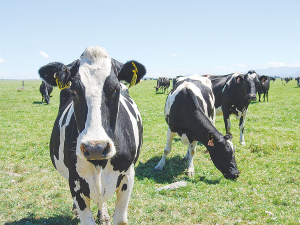$20m facial eczema research funding announced
Government and the red meat sector are teaming up to help eradicate the significant impact of facial eczema (FE) on farmed animals.
 Not all animals affected show physical signs of FE and it’s estimated for every clinical case there will be 10 cows with subclinical FE.
Not all animals affected show physical signs of FE and it’s estimated for every clinical case there will be 10 cows with subclinical FE.
Facial eczema (FE) is a disease which causes lowered production, skin irritation and peeling and sometimes death.
FE is caused by a toxin (sporidesmin) produced by the spores of the fungus Pithomyces chartarum growing on pasture. The fungus grows in the dead litter at the base of pasture in warm moist conditions.
Sporidesmin, when ingested by cattle, damages the liver and bile ducts.
The damaged liver cannot rid the body of wastes and a breakdown product of chlorophyll builds up in the blood causing sensitivity to sunlight, which in turn causes inflammation of the skin.
Signs to look for:
Not all animals affected with FE show physical signs (i.e. clinical FE) although liver damage (i.e. subclinical FE) has occurred. It is estimated that for every clinical case there will be 10 cows with subclinical FE.
Milk production of animals with subclinical FE can be depressed by up to 50%.
Blood tests can be used to monitor the extent of subclinical FE.
Badly damaged liver tissue will not regenerate. Chronic wasting and/ or death may occur at the time of damage or months later when the animal is under stress (e.g. calving).
There is no cure for FE so prevention is the only way of protecting animals.
To be effective, preventative measures need to be in place before eczema spores are found.
Preventative measures include monitoring pasture spore count and either dosing animals with zinc or spraying pastures with a fungicide.
Breeding cows that are more tolerant to facial eczema is a solution to reduce the impact from facial eczema in the long term.
Cows showing clinical signs of facial eczema can recover if prompt action is taken.
Practical indicators of recovery include liveweight gain and improvement in body condition score (BCS).
Source: DairyNZ
Trade Minister Todd McClay says New Zealand has no intention of backing down in a trade dispute with Canada over dairy products.
There have been leadership changes at the Hamilton-based Dairy Goat Co-operative, which has been struggling financially in recent years.
Horticulture NZ chief executive Nadine Tunley will step down in August.
OPINION: In recent years farmers have been crying foul of unworkable and expensive regulations.
Another 16 commercial beef farmers have been selected to take part in the Informing New Zealand Beef (INZB) programme designed to help drive the uptake of genetics in the industry.
Trade Minister Todd McClay says Kiwi exporters will be $100 million better off today as the NZ-EU Free Trade Agreement (FTA) comes into force.

OPINION: The new government has clearly signalled big cuts across the public service.
OPINION: Your canine crusader is not surprised by the recent news that New Zealand plant-based ‘fake meat’ business is in…